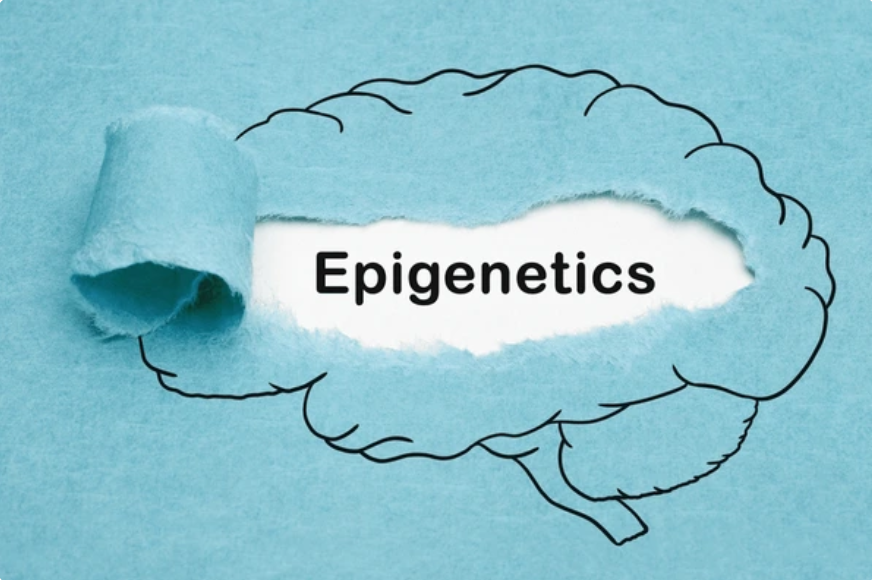Imagine that there were switches on your DNA that could be flipped on or off to control which of your genes were expressed and which were ignored. It may sound elementary, but this is essentially how epigenetics work. Epigenetics is the process that determines how a person’s genes are expressed, without actually altering the DNA bases.
Before we move on, let’s take a look at some useful vocabulary:
| Useful VocabularyGenome → This is all of an organism’s genetic material.DNA bases → They form base pairs that connect to two strands of the DNA double helix. These sequences of bases code for physical traits, such as hair color, height, and more.Gene → This carries coding that determines your traits. Transcription → During this first phase of gene expression, a copy of the DNA is made. This copy is called messenger RNA or mRNA. The genetic information in mRNA is used in the second phase of gene expression (translation) to create a protein. Transcription factors → These are proteins that bind to specific DNA sequences and are crucial for gene expression. Histones → The proteins that DNA wraps around. |
Now that we know the basics, let’s dive in a little deeper.
Epigenetic Marks
With the help of epigenetic marks, which are chemical modifications, epigenetics can influence gene activity. Here are some examples of different epigenetic marks:
- DNA Methylation: The most common epigenetic modification is DNA methylation. This is when methyl groups, which can attach to DNA, have the ability to stop transcription from occurring. Therefore, the DNA that is methylated will not be actively transcribed and no protein will be produced from that gene.
- DNA Demethylation: DNA demethylation can actually remove methyl groups, allowing for that DNA to be actively transcribed.
- Histone Methylation: Epigenetic marks located on histones are known as histone methylation. Additionally, histone methylation can be modified more easily compared to DNA methylation.
- Histone Acetylation: This occurs when acetyl groups are attached to certain parts of the histones, creating a wedge between the DNA and histone. This allows the DNA to be wrapped around the histone more loosely, so that transcription factors can access the DNA. As a result, the gene is more likely to be switched on.
- Histone Deacetylation: In this modification, acetyl groups are removed from histones. When this occurs, the DNA will be tightly wrapped around histones. Transcription is hindered due to the fact that necessary transcription factors and enzymes have limited access to the DNA (1).
Depending on the gene, epigenetic marks can be good or bad for the person in question. For instance, turning on tumor suppressor genes, which stop tumors from growing, would be positive. However, turning on mutated genes that have the ability to cause cancer, known as oncogenes, would clearly be negative.
Inheritance
Can epigenetic marks be inherited? The answer is yes and no. Let’s take a look at some examples.
During mitosis, when the parent cell divides to create two daughter cells, the daughter cell can inherit its parent cell’s epigenetic mark.
When a sperm cell and egg cell form a zygote, epigenetic marks can be erased. However, some may not be removed and thus those epigenetic modifications would then be passed on to the next generation (1).
Environmental Stimuli
Interestingly, you can actually impact your epigenome due to environmental influences. This includes an individual’s diet, exposure to pollutants, and stress levels, as well as lifestyle (3).
According to the National Institutes of Health, physical exercise has major effects on epigenetic modifications. They found that changes in DNA methylation patterns that occurred due to physical exercise led to an increase of “the expression of genes involved in tumor suppression and decrease the expression levels of oncogenes.” Concretely, this means that when you exercise you are potentially keeping tumor-forming and cancer-causing genes from being activated (2).
Diseases & Research
Epigenetic regulation is essential for normal development and cell function. However, if there are errors (such as placing epigenetic marks on the wrong gene or removing the epigenetic marks) in this process, it can lead to various disorders (3). Many diseases that involve genetic components, such as leukemia, can include epigenetics. Currently, researchers are targeting epigenetics marks acting on the genome in hopes to advance treatment options for cancer and other medical conditions (1).
Additionally, epigenetics are helping scientists provide insight about how diseases start and develop, as well as the role of the environment in diseases. As research continues, epigenetics is sure to have a progressively vital role in our understanding of biology, health, and inheritance.
Conclusion
Epigenetics demonstrate how complex our genes really are. It shows that our DNA isn’t fixed, but rather determined by epigenetic “switches” that can turn our genes on and off, environmental factors such as diet and exercise, and modifications passed down through generations. Epigenetics provides a better understanding of disease development and can allow for improved treatments. This field could allow for more personalized medical treatments and could prevent genetic disorders in the future. A basic understanding of epigenetics can also empower us to make healthy lifestyle choices as we remember that our daily actions could potentially affect our gene expression.
Works Cited
- “Epigenetics.” YouTube, YouTube, www.youtube.com/watch?v=MD3Fc0XOjWk. Accessed 17 Jan. 2025.
- Moosavi, Azam, and Ali Motevalizadeh Ardekani. “Role of Epigenetics in Biology and Human Diseases.” Iranian Biomedical Journal, U.S. National Library of Medicine, Nov. 2016, pmc.ncbi.nlm.nih.gov/articles/PMC5075137/.
“What Is Epigenetics?: Medlineplus Genetics.” MedlinePlus, U.S. National Library of Medicine, medlineplus.gov/genetics/understanding/howgeneswork/epigenome/. Accessed 17 Jan. 2025.

